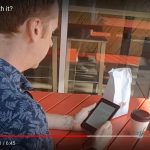Inspired by Ted Nelson, I’ve remixed my 3rd blog post and integrated some related concepts and key words from classmate’s 3rd blog post, and from the readings in module 3.
(Sorry, I was unable to figure out how to embed the artifact in this post.)
The idea behind this remix was to try to blend the visual with text and elevate it to something beyond digital paper. I’ve never used wordart before and it was pretty neat. I experimented a great deal with different lengths of phrases, different images and colours. I originally wanted to design something more 3-d looking but I couldn’t manipulate any of the 3-d images to look the way I wanted.
I chose the hard-disk image to make that connection back to the advent of digital writing and memory. This was a really fun way to synthesize my ideas and I am reflecting on how I could push it further and incorporate elements of this in the final project.
References:
Bolter, Jay D. Writing Space: Computers, Hypertext and the Remediation of Print. Routledge, 2001.
Bush, V. (1945). As We May Think. The Atlantic Monthly, 176(1), 101-108. Retrieved from https://www.theatlantic.com/magazine/archive/1945/07/as-we-may-think/303881/
Glasersfeld, E. V. (2008). Learning as a Constructivist Activity. AntiMatters, 2(3), 33-49.
Kress, G . (2005). Gains and Losses: New forms of texts, knowledge and learning. Computers and Composition. 22(1), 5-22. Retrieved from https://ac-els-cdn-com.ezproxy.library.ubc.ca/S8755461504000660/1-s2.0-S8755461504000660-main.pdf?_tid=45611da7-380f-4a1f-a15f-ab93182fb22e&acdnat=1532029119_e2e54b8e18ceb6a6
New London Group. (1996). A pedagogy of multiliteracies: Designing social futures. Harvard Educational Review 66(1). Retrieved July 18, 2018, from http://newarcproject.pbworks.com/f/Pedagogy of Multiliteracies_New London Group.pdf
Nelson, T. (2007, January 29). Transclusion: Fixing electronic literature. Retrieved from YouTube: https://www.youtube.com/watch?v=Q9kAW8qeays
TheTedNelson. (2018, April 13). Xanadu Basics 1a: VISIBLE CONNECTIONS. Retrieved from YouTube: https://www.youtube.com/watch?v=hMKy52Intac


Carri-Ann Scott
July 22, 2018 — 2:06 pm
Hi, Sally.
This is a great visualization. I like the connection to the disk imagery. The overall effect is more intense than I got when using WordClouds for my project.
How much control did you have over the placement of the words?
How would the imagery change if you added colour?
Were you surprised by the prominence of any of the words and did they make you take another look at your existing perceptions?
sally bourque
August 2, 2018 — 4:36 am
Hi Carrie-ann, You can control everything! The colour, the placement, the amount of animation… I tried more colourful pictures but didn’t change the colours on the one I selected because throughout my experimentation and by the time I tried this image I found ‘less is more’ was the best philosophy. This may not be the case with a few select pictures but it was with several I experimented with.
I think being able to manipulate the size and type of font is most effective because you can visually make the phrases you want more prominant. I suppose higher contrasting colours might do this as well. I didn’t realize this at the time, but it relates to the concept of “breakout of the visual” because the words are literally “standing out” from the visual display.
michael yates
July 24, 2018 — 8:27 pm
It looks like the evolution of the wordle.
I find it really interesting how the word processor was manipulated to simply reproduce paper (Whether this was a practical decision, or one based on economics is up for debate). It is funny how we bring in our biases and comforts into the technological realm, those that create these wonders are doing it from pre formed (or imposed) biases / comforts. As another example is the presentation, I never really made the connection but “slides” are from the old slide projectors from the 1960’s (I decided to do my final assignment for this course on the evolution of the presentation). So instead of making something better, they simply made it easier but kept the confines of the old system (just like the word processor!).
Nelson wanted hypertext to be the ultimate open reference system, where everything was connected (which is hopefully what is happening now with HTML 5.1+). Let’s see what happens!
sally bourque
August 2, 2018 — 4:47 am
Yes, exactly, with regard to slideshow! I realized the same thing about the “stylus” for modern day tablets when I researched history of the pen! The first time I heard of a stylus was when select smartphones started offering them. (but they never caught on for Smart phones.)
Nelson does seem adamant that “visible connections” will revolutionize the internet as we know it. However, I realize he is more passionate about the underlying infrastructure and I have a sense that there is more to it than what he is trying to “pitch” to everyone.
The newest technologies are asking more and more from us as users. Hypertexts require that we be involved in decision making, tracking and critical thinking more than reading a linear text does. All media seems to be moving from passive to interactive while at the same time becoming accessible so that we can also be producers of different media. It’s a very creative time to be communicating!